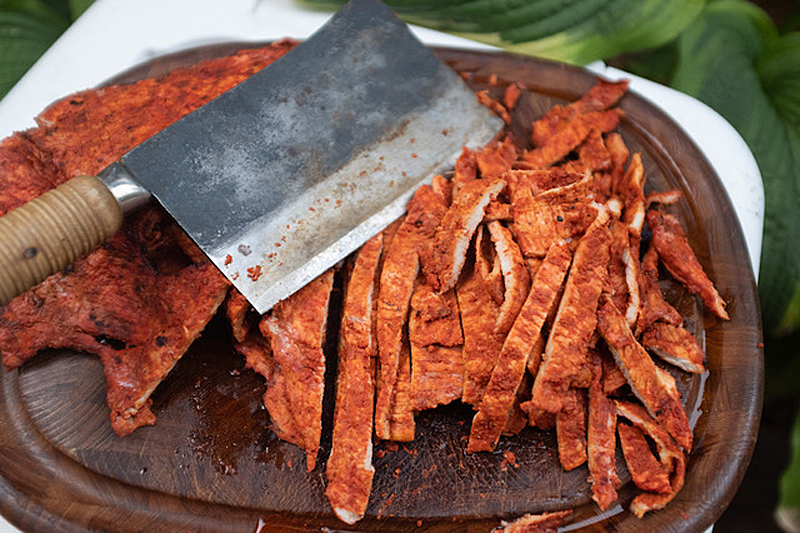PHOTOS BY PHIL CALVIT
In this Year of COVID (knock on wood, our only Year of COVID), if we’re entertaining at all, we’re doing it in our backyards. Which, for my household, often means some version of this informal and easy-ish taco feast, provisioned (of course) with an ample supply of compostable plates and utensils, plus antiseptic wipes. We space some chairs around the deck and yard, put something festive on the Bluetooth speaker, and spend a couple of hours eating, gabbing, and feeling—well, rather normal.
Our meat of choice is enchilada de puerco (often known as cecina enchilada), which can be roughly translated as “chili-ed pork.” At the excellent Andale Mercado adjacent to the also excellent Andale Taqueria out by the Menards on Nicollet north of I-494, I’ve seen a guy take a long knife to a whole pork shoulder, cut the thinnest of slices from the top, reverse course, cut another slice, and so on, all the way through the enormous hunk of meat: he’s basically cutting sashimi, but on a gigantic, porky scale. The slices of lean meat are then marinated in some magical orange-red stuff. Cinco de Mayo Mercado, my go-to source for Mexican meatstuffs and most other Mexican/Hispanic ingredients, tells me that their enchilada is marinated in guajillo chilis and a mixture of spices, vinegar, and oil. It’s amaaaaaazing, and at $6-something a pound, it can help feed a yard full of safely-spaced people for a couple of bucks a head.
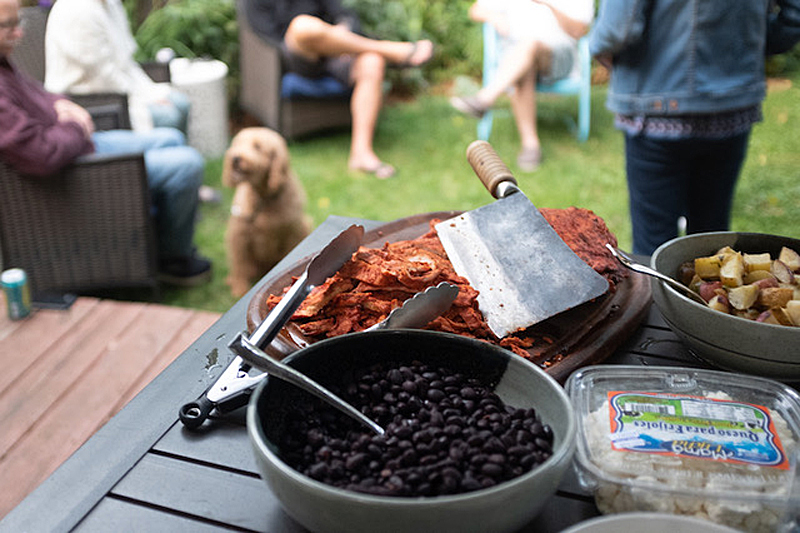 I grill the sheets of taco meat over high heat, on either gas or charcoal (the latter gives you more heat, and therefore a better char on your meat). The slices are large and unwieldy, so you’ll want to lay them on the grill using your hands; have a dish towel or roll of paper towels ready next to the grill, or by the time you’ve finished cooking, you’ll look like you’ve slaughtered some sort of orange-blooded animal. The sheets of meat are so thin they cook in moments; I grill them only long enough to get a light char on each side—a couple of minutes, at most—then transfer each sheet to a platter, where I cover them with foil while I cook the rest; then, when the grilling is done, I chop it all with a big-ass meat cleaver to impress the guests, and boost my own self-image. The resulting strips of lean seared pork have a nice chew to them, with a slightly sour tang that packs a lot of flavor, with very little “spice,” despite the chilis.
I grill the sheets of taco meat over high heat, on either gas or charcoal (the latter gives you more heat, and therefore a better char on your meat). The slices are large and unwieldy, so you’ll want to lay them on the grill using your hands; have a dish towel or roll of paper towels ready next to the grill, or by the time you’ve finished cooking, you’ll look like you’ve slaughtered some sort of orange-blooded animal. The sheets of meat are so thin they cook in moments; I grill them only long enough to get a light char on each side—a couple of minutes, at most—then transfer each sheet to a platter, where I cover them with foil while I cook the rest; then, when the grilling is done, I chop it all with a big-ass meat cleaver to impress the guests, and boost my own self-image. The resulting strips of lean seared pork have a nice chew to them, with a slightly sour tang that packs a lot of flavor, with very little “spice,” despite the chilis.
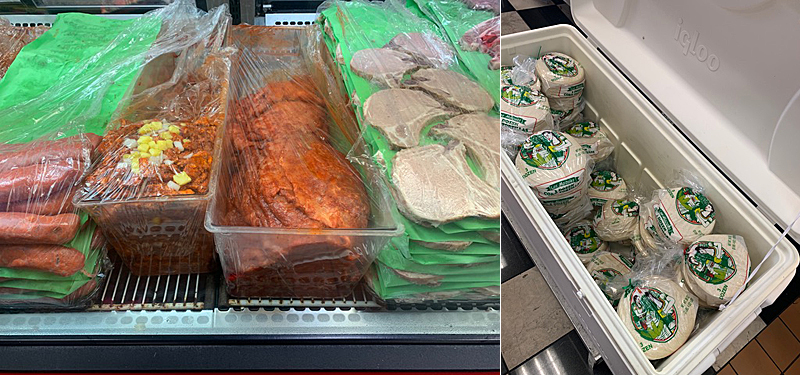 As food snobs (hey, you’re a food snob: you’re getting the Heavy Table newsletter, right?), we’re insistent to the point of militancy on serving corn tortillas made that very day—preferably, only a couple of hours beforehand. We’re lucky to now have a number of excellent tortillerias in town. My closest source is the aforementioned Cinco De Mayo Mercado, across Nicollet from Rainbow Chinese, between 28th and 29th. The fresh tortillas are kept in a large cooler next to the meat counter, still warm from their manufacture. They go for a couple of bucks for a 36-tortilla packet. I take a little Playmate cooler with me to keep the tortillas warm until serving. On the drive home, I keep the cooler within reach of the driver’s seat, and eat 2-6 of them en route.
As food snobs (hey, you’re a food snob: you’re getting the Heavy Table newsletter, right?), we’re insistent to the point of militancy on serving corn tortillas made that very day—preferably, only a couple of hours beforehand. We’re lucky to now have a number of excellent tortillerias in town. My closest source is the aforementioned Cinco De Mayo Mercado, across Nicollet from Rainbow Chinese, between 28th and 29th. The fresh tortillas are kept in a large cooler next to the meat counter, still warm from their manufacture. They go for a couple of bucks for a 36-tortilla packet. I take a little Playmate cooler with me to keep the tortillas warm until serving. On the drive home, I keep the cooler within reach of the driver’s seat, and eat 2-6 of them en route.
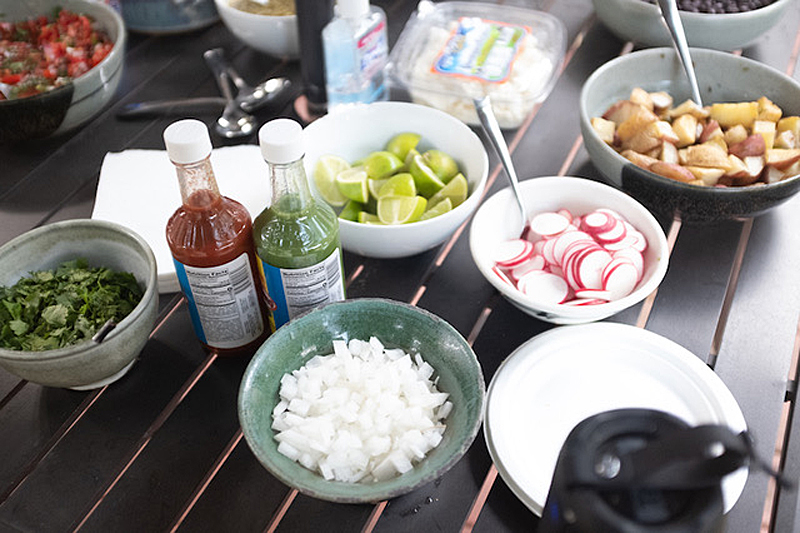 Setting the Table
Setting the Table
To serve this particular taco feast, we piled a table with the platter of meat, stacks of tortillas (give them a quick shot in the microwave if they’ve cooled off, covered with a damp paper towel), and the following:
Chopped white onion
Lime wedges
Chopped cilantro
Thinly sliced radishes
Crumbly cheese: this time, I got a nice salty crumbly cheese labeled “Queso para frijoles.” Cotija also works well, or, for that matter, feta
Bottled hot sauce (we like to have both the orange and green versions of El Yucateco on the table: they make a colorful, festive pairing)
Fresh salsa and/or pico de gallo if you’ve been industrious enough to make some
It’s corn season, so I grilled some corn. We had some potatoes around, so we roasted those and tossed them with chunks of charred-then-peeled poblano chilis. I made fresh guac, salsa verde, and pico de gallo; I’ve included recipes for the guac and salsa.
For dessert, we’ve discovered a silver lining to the pandemic: people absolutely LOVE ice cream sandwiches! And Dove bars! All of those hygienically wrapped, single-serving frozen desserts—people are sooooo relieved to plunk down in their chairs happily nibbling away at those, instead of poking at your latest flaccid, over-worried, underset flan!
 Homemade Salsa Verde
Homemade Salsa Verde
No industrial salsa at my home, thank you very much. Once you’ve made this basic salsa verde, and discovered how easy it is, you’ll never go back to the jarred stuff (an important exception: the house-made salsas at Latin markets tend to be fabulous: grab those when you see them).
6-8 medium-to-large tomatillos, husks removed, rinsed
1/2 large white onion, halved through its equator, end sliced off so it sits flat
1-2 serrano chilis, stemmed
4-6 cloves garlic, unpeeled
2 teaspoons kosher salt
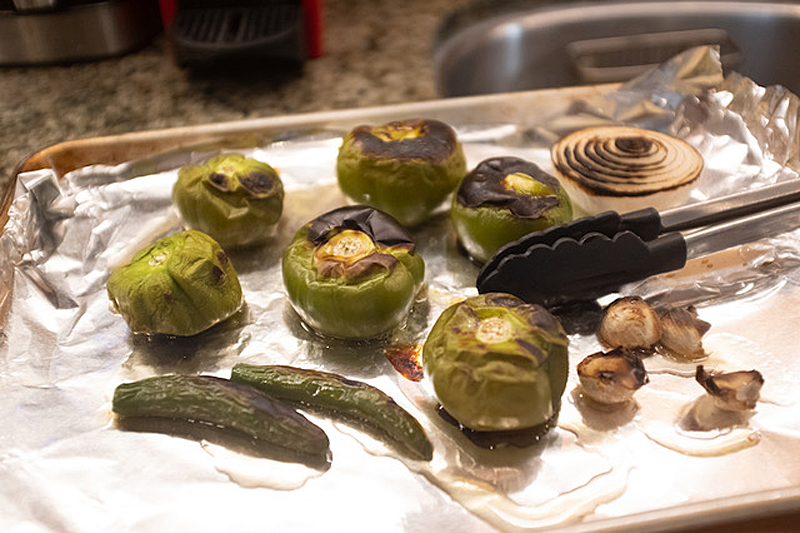 Start the broiler in your oven. Line a sheet pan with aluminum foil. Put the tomatillos, onion half, serranos and garlic in the middle of the pan and place beneath the broiler. Check after a few minutes (ovens vary greatly in their broiling capabilities).
Start the broiler in your oven. Line a sheet pan with aluminum foil. Put the tomatillos, onion half, serranos and garlic in the middle of the pan and place beneath the broiler. Check after a few minutes (ovens vary greatly in their broiling capabilities).
As the top side of each ingredient starts to char, turn them with tongs until they become blackened on both sides, but not turned to coal. As each ingredient becomes ready, remove with tongs and place in a bowl. The tomatillos will be all saggy and squishy, so you might need to pick up the sheet of foil to pour the juices into the bowl with the other ingredients.
Let the ingredients cool for a bit (peel the garlic when it’s cool enough), then put everything except for one serrano in a blender—or food processor, or NutriBullet—with the salt. Blast everything with the machine till it’s smooth, sample a bit, and decide whether you want to add some or all of the second chili. I find that one serrano gives the salsa a nice little kick; two makes it flat-out spicy.
We serve this salsa both as an appetizer with chips (alongside the guac), and again later as a condiment for the tacos.
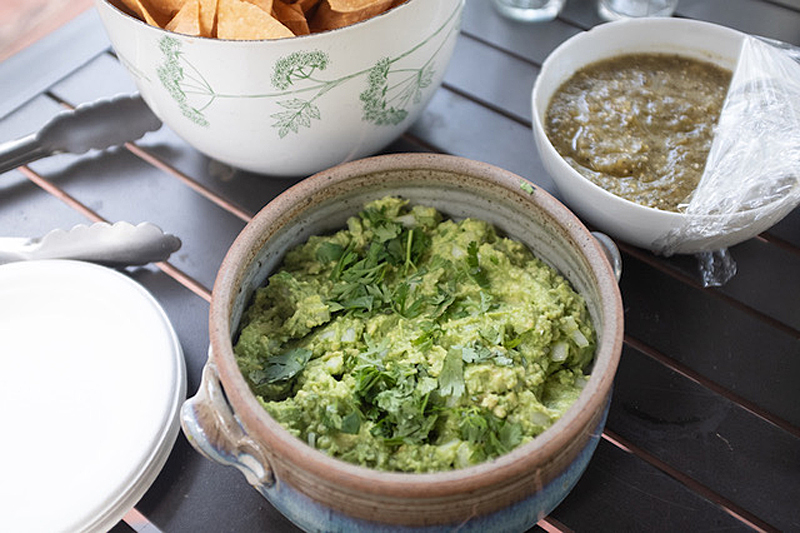 Guacamole
Guacamole
You can make exceptional guacamole with just three ingredients: ripe avocados, lime juice, and salt. Get the balance right, and you’ve got great guac, no matter what else you add or don’t add. I always use finely chopped white (or red: I’m no purist) onion in mine, and sometimes, chopped cilantro. I’m not a fan of tomato in my guac. Remember, it’s all about the lime and salt.
4 ripe Haas avocados (the dark nubby ones; the larger, smoother variety is usually stringy and disgusting, at least the ones we get in Minnesota)
1/2 medium white onion, finely diced (about 1/2 cup)
Coarse kosher salt
Juice of 1-2 limes
Cilantro (?)
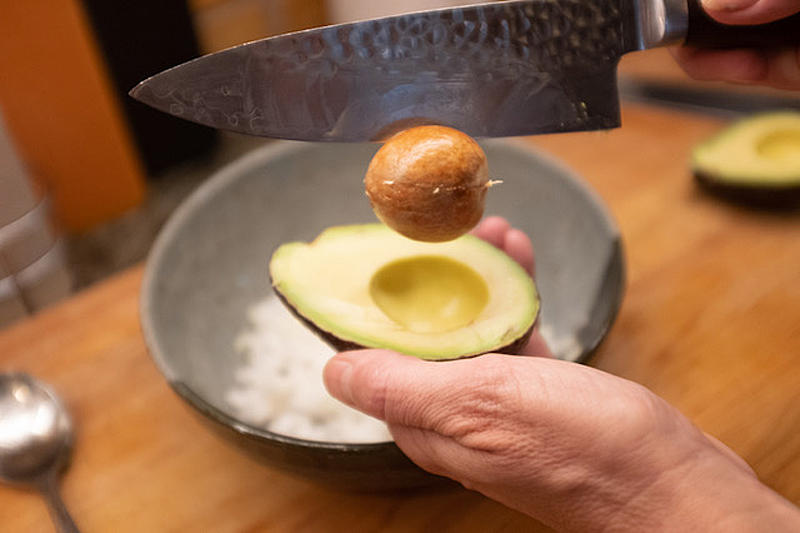 Slice the avocados in half lengthwise around the pit, give the halves a twist and separate them. If you’re confident with the avocado pit knife trick, remove the pit that way (Hold the half containing the pit in one hand, then sharply but lightly whack the pit with a sharp chef’s knife, so that the knife blade just wedges into the pit. Then twist the knife to remove the pit from the avocado. Be aware that laceration is possible).
Slice the avocados in half lengthwise around the pit, give the halves a twist and separate them. If you’re confident with the avocado pit knife trick, remove the pit that way (Hold the half containing the pit in one hand, then sharply but lightly whack the pit with a sharp chef’s knife, so that the knife blade just wedges into the pit. Then twist the knife to remove the pit from the avocado. Be aware that laceration is possible).
Scoop the avocado flesh into a medium bowl, add two-thirds of the chopped onion, a teaspoon of the salt, and the juice of one lime. Mash it all with the back of a large fork, taking care not to make it too smooth—the chunks are what tell your guests that you love them enough to make them fresh guacamole. Sample a bit; then add onion, salt or lime juice to taste. The lime and the salt should definitely be there, but not overwhelm things. For this batch, I ended up using two teaspoons of salt and the juice of 1-1/2 limes.
To serve, if you’re concerned with appearances, scoop your guac into a less-messy bowl, and top with chopped cilantro and/or thinly sliced radishes if you really want to impress people.

